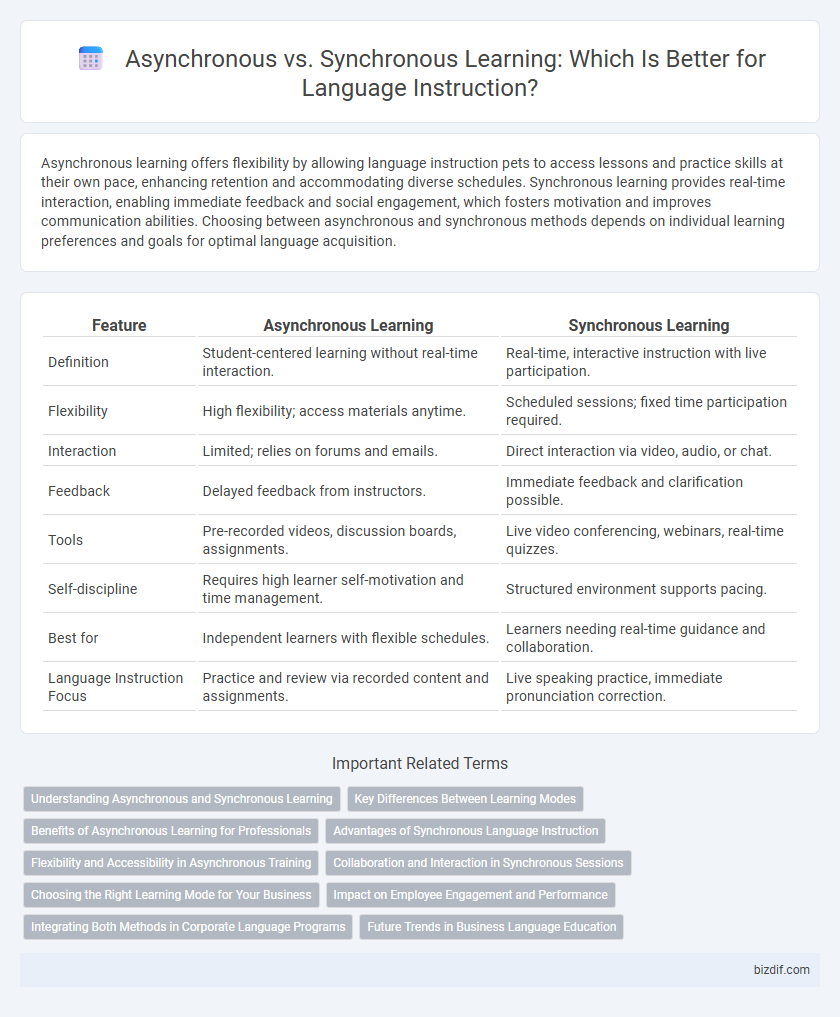Asynchronous learning offers flexibility by allowing language instruction pets to access lessons and practice skills at their own pace, enhancing retention and accommodating diverse schedules. Synchronous learning provides real-time interaction, enabling immediate feedback and social engagement, which fosters motivation and improves communication abilities. Choosing between asynchronous and synchronous methods depends on individual learning preferences and goals for optimal language acquisition.
Table of Comparison
| Feature | Asynchronous Learning | Synchronous Learning |
|---|---|---|
| Definition | Student-centered learning without real-time interaction. | Real-time, interactive instruction with live participation. |
| Flexibility | High flexibility; access materials anytime. | Scheduled sessions; fixed time participation required. |
| Interaction | Limited; relies on forums and emails. | Direct interaction via video, audio, or chat. |
| Feedback | Delayed feedback from instructors. | Immediate feedback and clarification possible. |
| Tools | Pre-recorded videos, discussion boards, assignments. | Live video conferencing, webinars, real-time quizzes. |
| Self-discipline | Requires high learner self-motivation and time management. | Structured environment supports pacing. |
| Best for | Independent learners with flexible schedules. | Learners needing real-time guidance and collaboration. |
| Language Instruction Focus | Practice and review via recorded content and assignments. | Live speaking practice, immediate pronunciation correction. |
Understanding Asynchronous and Synchronous Learning
Asynchronous learning enables students to access instructional materials and complete tasks at their own pace, promoting flexibility and individualized study schedules. Synchronous learning requires real-time interaction between instructors and learners, fostering immediate feedback and collaborative engagement. Understanding these differences helps educators design effective language instruction tailored to diverse learning preferences and technological access.
Key Differences Between Learning Modes
Asynchronous learning offers flexibility by allowing students to access materials and complete assignments at their own pace, ideal for diverse schedules and self-motivated learners. In contrast, synchronous learning involves real-time interactions with instructors and peers, fostering immediate feedback and collaborative engagement. Key differences include timing of participation, level of interaction, and adaptability to individual learning preferences, impacting overall student engagement and performance.
Benefits of Asynchronous Learning for Professionals
Asynchronous learning offers professionals the flexibility to access language instruction on their own schedule, enabling them to balance work commitments with skill development. It allows learners to progress at their own pace, reinforcing retention through repeated review of materials. This format supports diverse learning styles and provides the convenience of accessing content anytime, which is crucial for busy professionals managing multiple responsibilities.
Advantages of Synchronous Language Instruction
Synchronous language instruction offers real-time interaction, enhancing immediate feedback and clarification during lessons, which significantly improves language acquisition and conversational skills. This mode fosters stronger student engagement and motivation through live discussions, collaborative activities, and direct teacher support. Furthermore, synchronous learning supports structured schedules that help learners maintain consistent practice and accountability essential for mastering new languages.
Flexibility and Accessibility in Asynchronous Training
Asynchronous learning offers unparalleled flexibility by allowing learners to access course materials and complete assignments at their own pace, accommodating diverse schedules and time zones. This mode of instruction enhances accessibility by enabling participants to engage with content anytime and from any location with internet access, supporting learners with varying personal and professional commitments. The self-paced nature of asynchronous training fosters inclusive education, particularly for those needing to balance language acquisition with other responsibilities.
Collaboration and Interaction in Synchronous Sessions
Synchronous learning fosters real-time collaboration and interaction, enabling immediate feedback and dynamic discussions among participants. This live engagement enhances language acquisition through instant clarification of doubts and conversational practice. The structured schedule promotes consistent peer communication, strengthening community and motivation within language instruction.
Choosing the Right Learning Mode for Your Business
Selecting the optimal learning mode for your business hinges on the nature of your workforce and training objectives. Asynchronous learning offers flexibility and self-paced modules ideal for global teams with varying schedules, enhancing accessibility and retention. Synchronous learning fosters real-time interaction and immediate feedback, promoting collaboration and engagement for training that benefits from direct instructor support and group discussion.
Impact on Employee Engagement and Performance
Asynchronous learning enhances employee engagement by allowing learners to access materials at their convenience, fostering self-paced mastery and reducing scheduling conflicts. Synchronous learning drives immediate interaction and real-time feedback, which can boost motivation and collaboration but may limit flexibility. Combining both methods can optimize performance by balancing engagement with structured support in corporate language training programs.
Integrating Both Methods in Corporate Language Programs
Integrating asynchronous and synchronous learning in corporate language programs enhances flexibility and engagement by combining self-paced study with real-time interaction. Asynchronous components, such as video lessons and interactive exercises, allow employees to learn at their convenience, while synchronous sessions foster immediate feedback and collaborative practice. This blended approach maximizes language acquisition efficiency, meeting diverse learning preferences and improving overall training outcomes.
Future Trends in Business Language Education
Future trends in business language education emphasize the integration of asynchronous learning platforms that offer flexibility and personalized pacing, supported by AI-driven language assessment tools. Synchronous learning continues to evolve with real-time virtual classrooms enhanced by immersive technologies such as VR and AR, promoting interactive communication skills essential for global business environments. Hybrid models increasingly dominate, combining the scalability of asynchronous modules with the engagement of synchronous sessions to optimize learner outcomes and accommodate diverse professional schedules.
Asynchronous Learning vs Synchronous Learning Infographic

 bizdif.com
bizdif.com